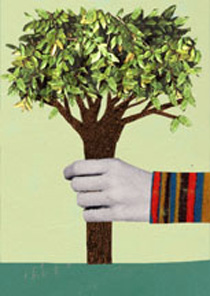Being Jewish
Commentary
Commentary: Learning Diversity from Trees

Like a tree, the Jewish holiday for trees has changed and evolved throughout history. In the 16th century, the kabbalists of Safed transformed Tu Bishvat into a mystical nature holiday including a seder.
The Zionist movement rediscovered Tu Bishvat 100 years ago as a way to reclaim and develop the Land of Israel. To paraphrase the 20th-century Zionist philosopher Ahad Ha’am, one could say, “More than the Jews have kept the Land of Israel, the Land of Israel has kept the Jews.” However, during the past 25 years, in the wake of the environmental movement, Tu Bishvat—which falls this year on February 9—has become Judaism’s environmental holiday par excellence.
Not mentioned in the bible, the holiday’s roots formed during the Second Temple period as the rabbis grappled with a number of biblical laws: Leviticus (19:23-25) states that for the first three years of a tree’s life, its fruit cannot be eaten. In the discussion of that law, the rabbis also discuss the laws of the first fruits, bikkurim (Numbers 18:13), as well as the laws of tithes (Leviticus 27:30).
We first hear about Tu Bishvat (numerically, “Tu” equals 15) in the Mishna: “The first of Shevat is the New Year for Trees, according to the words of the School of Shammai; the House of Hillel says it is on the 15th of Shevat” (Rosh Hashana 1:1). That is to say, the New Year for Trees was the demarcation date from one arbor year to the other.
So what is the disagreement between Hillel and Shammai about? Neither they nor their followers left an explanation. The 15th of Shevat makes sense because it is during the full moon—when many Jewish holidays are observed—which can support Hillel’s thinking. But how did Shammai make his determination? Was it because he was influenced by the environment of Israel’s coastal plain, which received more rain during the winter than the inland hill country? In addition, the coastal plain’s rainy season abates quicker and also warms up earlier, leading to sap running and buds forming sooner. Conversely, perhaps Hillel was more influenced by the inland hill county, where the majority of people lived at the time; seasonally, it lagged about two weeks behind the coastal plain.
While we follow Hillel, the voice of Shammai reminds us that even though Israel is a small country, its environment is varied—an important lesson for us, whether we live in Israel or the diaspora. If we are to take Tu Bishvat seriously as our environmental holiday, we must become more attuned to the subtle as well as grand diversity of our world.
To observe the details of our world is one of the foundations of living a holy life in Judaism. The word for holy is kodesh, which contains the concept of separation, individuality. Before we can fully understand the unity of the world as expressed in the Shema, we first need to notice and appreciate its diversity. In a similar vein, the rabbis teach us to say at least 100 blessings each day. Aside from our traditional blessings over fruit of the trees and earth and vines, Judaism bids us say blessings for the fragrance of trees and plants, when hearing thunder and seeing lightning, for rainbows, blossoms, mountains and oceans. This simple activity is a way we create—through every season and topography—an awareness of our environment that we particularly highlight on Tu Bishvat. H
Rabbi Michael M. Cohen is the director of special projects for the Arava Institute for Environmental Studies and the author ofEinstein’s Rabbi: A Tale of Science and the Soul (Shires Press;www.einsteinsrabbi.com).










 Facebook
Facebook Instagram
Instagram Twitter
Twitter
Leave a Reply